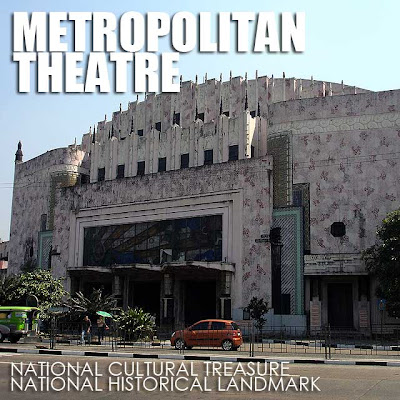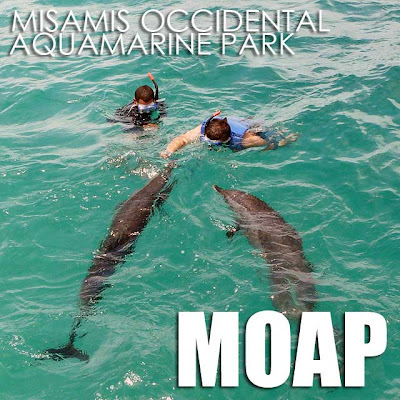
A lot of people had suggested that I visit
Dolphin Island at the
Misamis Occidental Aquamarine Park (MOAP) to check out their swimming with dolphins experience. It had been advertised as a
Dolphin Rescue Center where injured dolphins are brought to recover. In fact, when you land in Ozamiz Airport, one of the first things you'll see is a tarpaulin promoting the place. So it was worth checking out.
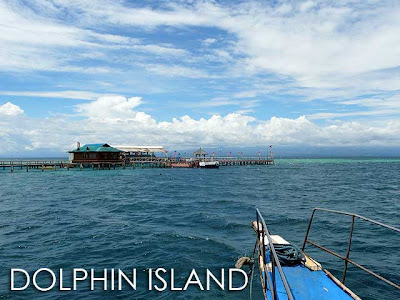
Entrance to MOAP is Php10 per head. From the MOAP Visitors' Center, you walk to the ferry port where another ticket counter will charge you Php250 for the round-trip boat ride and entrance to Dolphin Island which is about 20 minutes away.
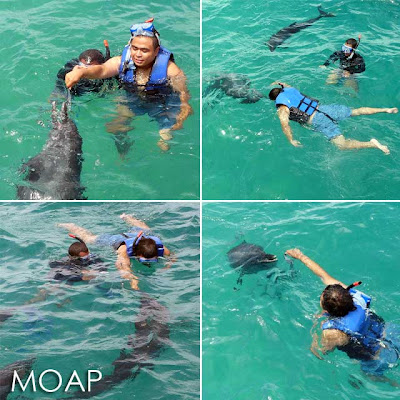
At Dolphin Island, you pay another Php300 for the swimming with the dolphins experience and gear rental. A guide will take you into the enclosure and hold the bag of fish you will feed the dolphins. To be honest, I actually enjoyed the experience because the dolphins were quite playful as I fed them the fish. Unlike the dolphin shows which has elicited a lot of opposition from animal rights activists, they do not train the dolphins here to perform any tricks. They just swim around, albeit in captivity.
I had been asked by animal rights friends to find out if the dolphins were released after. Unfortunately, MOAP does not release the dolphins even after they recover. They are kept there for entertainment purposes. While I personally understand the existence of zoos, I do not agree that MOAP should continue to call it the Dolphin Rescue Center because part of rescue is release after recovery. I mean let's be straightforward that the dolphins there are kept in captivity even after recovery. So when people visit, they know what they are visiting.
This project had been promoted by none other than President Arroyo. She visited the island together with the Australian Ambassador. From what I understand, AusAID was somehow part of this project.
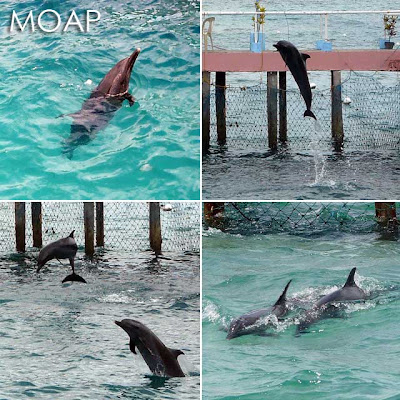
While dolphins in captivity are seen as okay by the general public (part of my childhood were visits to Ocean Park and SeaWorld), animal rights advocates are against it. Just to open the discussion, I would like to share
Dolphins in Captivity: FAQs for you to learn about the issues behind dolphins in captivity. So if you do visit MOAP and try out their swimming with dolphins experience, at least these issues are clear to you.
After you swim with dolphins, your guide will offer to take you to the coral reefs around the island. There is no fee for this but you'll have to give your guide a tip. I was floored by the variety of coral and fish species around the island. My guide gave me another piece of fish which I held in the water for other fish to eat. By the time I knew it, I only had bones left! There were also a lot of
Giant Clams in the area.
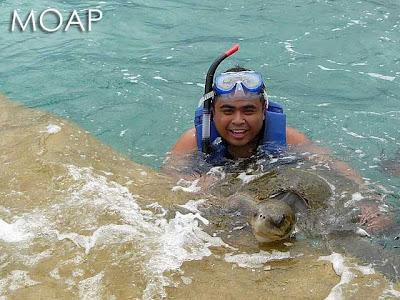
There's another pool were they keep a
pawikan. But watch out because it bites! Lunch is also available on the island so no need to worry about food. During low-tide, the sand around the area surfaces. But the island disappears when it's high-tide. So you can hang around there for some swimming.
Back at the mainland, I walked around the park while waiting for my ride back to Oroquieta City. I saw a wooden bridge that led to a mangrove forest which turned out to be a zoo. I was quite disconcerted seeing a dozen or so monkeys tied up with chains around the waist to bamboo poles. Looking at them doing nothing but walking up and down the poles was not a happy experience. For a project that won the
Galing Pook Award in 2005, I was a bit disappointed to see how they treated the monkeys. I hope the Provincial Government of Misamis Occidental does something about the zoo.
Anyway, I left with mixed feelings. While I genuinely enjoyed the swimming with the dolphins experience, I couldn't help but ponder on the issues behind dolphins in captivity.
